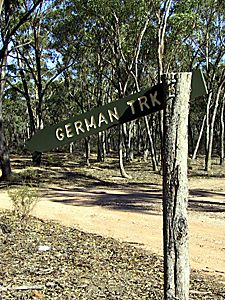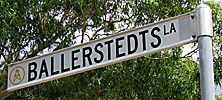![]()
Germans on Victoria's Gold Fields
| Intro 1 | Intro 2 | Bendigo | Ballerstedt | Eureka Rebellion | Frederick Vern | German Poem |
 |
Victoria in particular saw a massive increase in the number of immigrants from German-speaking countries as thousands of adventurers arrived. By 1861 there were 10,418 German-born people in Victoria. According to the Victorian census of 1854, 41.76% of the Germans in the colony were on the goldfields; Germans were the third-largest ethnic group on the Victorian goldfields after the British and the Chinese. There were about 15 places named "German Gully" scattered across Victoria's mining districts at the peak of the colony's gold rushes. Gold-miners tended to stick together with other miners of their national background, and on large goldfields such as Ballarat, Bendigo and Castlemaine the Germans had their own bands, clubs and Lutheran churches. Maldon had a Goethe Society for several years. It has been estimated that for a long time the number of German miners on the goldfields of Victoria was about 5,000. They left their influence in a variety of ways. << "German Track" - a bush track near Tarnagulla in the heart of Victoria's Golden Triangle. The track is close to German Gully, where German miners worked the Kangaroo Reef mine in the 1850s. |
 Of
the mines on the Victorian fields which produced more than 1000kg of gold,
some have names that show the involvement of German miners:
Of
the mines on the Victorian fields which produced more than 1000kg of gold,
some have names that show the involvement of German miners:
| Top | Back
| Chronology | Issues
| Students | Site Map |
auf Deutsch |
| Primary Sources (in German) | Bibliography
| Search |
German Australia © D. Nutting 2001